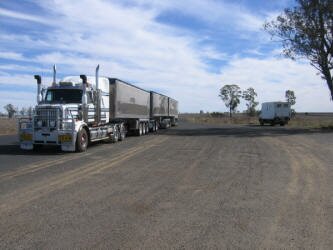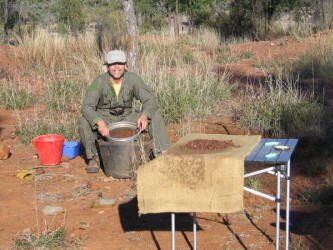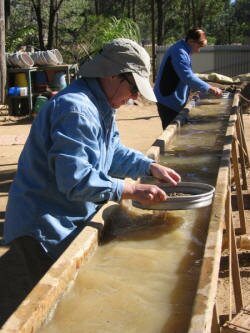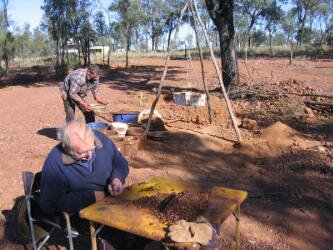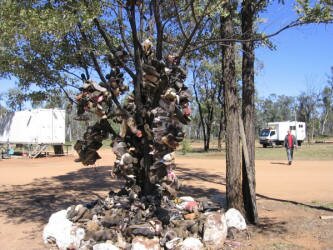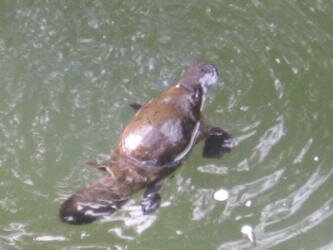|
July 18 - 23, 2007 We left our great bush camp just outside the entrance of Carnarvon NP and retraced our steps to the town of Rolleston. The town is very typical of the bush towns, one small main street with a fuel station/post office and a restaurant/bar/bottleshop (liquor store), a nice town park and a Rural Office that contains the town offices, library, bank and internet. We made stops for diesel and to update the website and pick-up our emails.
Our drive today took us the Gemfields. This is a region that is one of Queensland's most popular tourist areas, mainly for the Aussies. They are located in the hot and arid "hinterlands", not quite out as far as the Outback. The towns here are named: Emerald, Rubyvale and Sapphire. This is the world's largest sapphire producing area and for about $8au, we can buy a license to dig a hole and sift dirt to try and find our own sapphire or other gemstone. As we drove into the town of Sapphire, we passed places with names that conjured up the wild untamed region this must have been: piano tuner's grave, graves hill, ruby hill and big bessie. Looking for place to camp, we drove up to the town of Rubyvale and found that we crossed one of the imaginary lines that circles the earth, this one The Tropic of Capricorn. We made camp in town at a designated free camping area within walking distance of the town's main store. July 19, 2007 People come from all over the country to fossick for gem stones. Fossicking is the term used here for hand mining of gems and gold. Many of the people we met at the fossicking areas come up here every year to spend their winters digging in the dirt. The mining is carried out using hand tools: picks and shovels to dig shallow pits and trenches. The dirt dug out is then screened to remove the big stones and dirt. The remaining small stones are then washed by shaking the screens in a large bucket of water to remove any remaining dirt. The washed stones are then dumped onto a table and picked through using tweezers hoping to find a stone that looks like glass - a sapphire. There are many stories, but it seems that everyone knows of someone who "just walking around" found a gem stone worth tens of thousands of dollars. We heard many stories, but didn't meet any of these lucky people. The people we met had all spent weeks or even months digging for stones. Some of the fossickers showed us their finds, others complained that they had only found "a few" stones during their months long search. It seems that on average, a person might find two or three gem quality stones for each week that they are digging. Hard work for such a return. But the people were still digging, kind of caught up in something like a gamblers hope for a quick winning streak.
July 20, 2007 So in the morning we packed up and left empty handed - no surprise there. We then drove to the town of Emerald, the largest town in the area to replenish our supplies. While we were there we stopped at an agricultural truck washing facility and got a quick rinse for the Fuso. Then we found a laundromat, internet cafe and then on to grocery shopping. Quickly the day was used up, so we found a city camp spot in town between the botanical park and the football field. July 21, 2007
July 22, 2007 The drive to Eungella NP is up a really steep road, some of it as steep as 12% grade. The drive wound through the Pioneer River Valley past a handful of cute small towns, mostly one street wide. The valley is a prime sugar cane farming area and it turned out to be the start of the harvest season. The processing mill was operating and belching steam into the sky and all along the valley mechanical harvesters were chewing up the cane stalks and filling up special, small gauge train cars with the cane which would be transported to the mill. The mechanical harvesting is way different than the cutting by hand that we witnessed throughout Central and South America. Eungella NP is set in the mist shrouded mountains and is one of Queensland's most ecologically diverse parks. It contains plants and birds from both subtropical and tropical rainforests. When we hiked through the rain forest we were surprised to see so many tropical trees, like fig trees with their massive buttressed trunks.
July 23, 2007 Leaving the park behind, we drove to the coast for our first view of the Coral Sea and the Great Barrier Reef. This area is called The Whitsundays, for the islands found off-shore. At this point, the reef is close to its furthest point away from the mainland, so we don't expect to see it. But driving to the towns of Airlie Beach and Shute Harbour, we got nice views of the hilly peaks that make up the Whitsunday Islands NP. There are many tour boats taking people out to the islands, but we are waiting until we get further up the coast, maybe in Cairns, before we go out to the reef. It was nice to see that on a hike to a quiet cove, the beach was covered in bits of old coral. We have arrived in the tropics.
|
